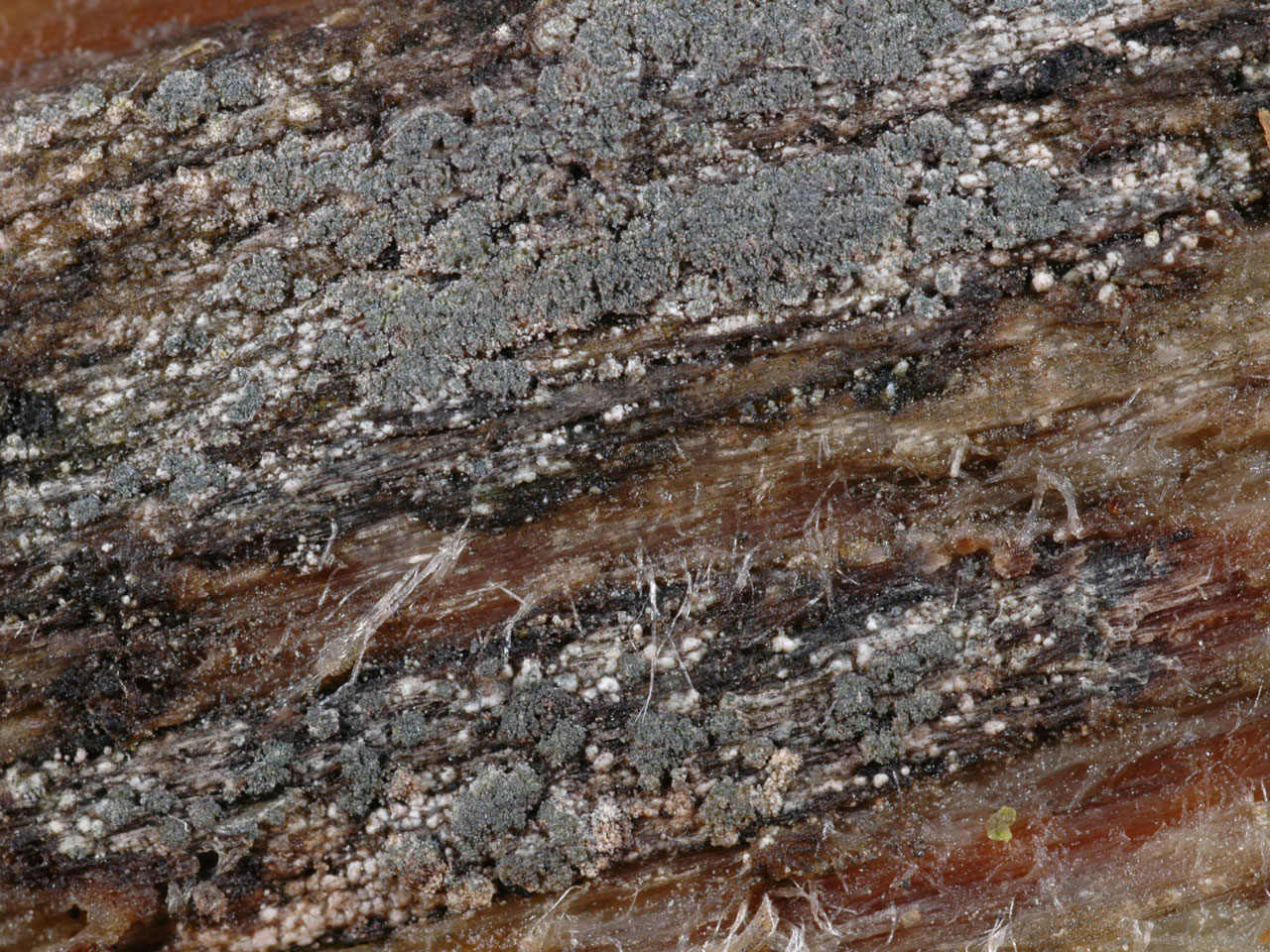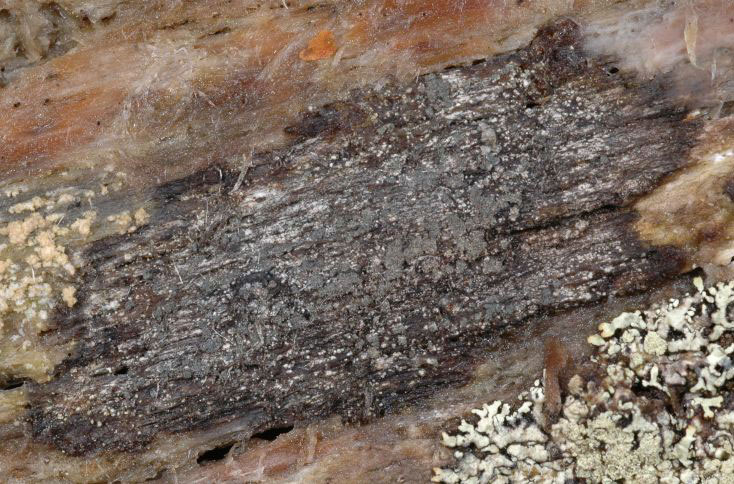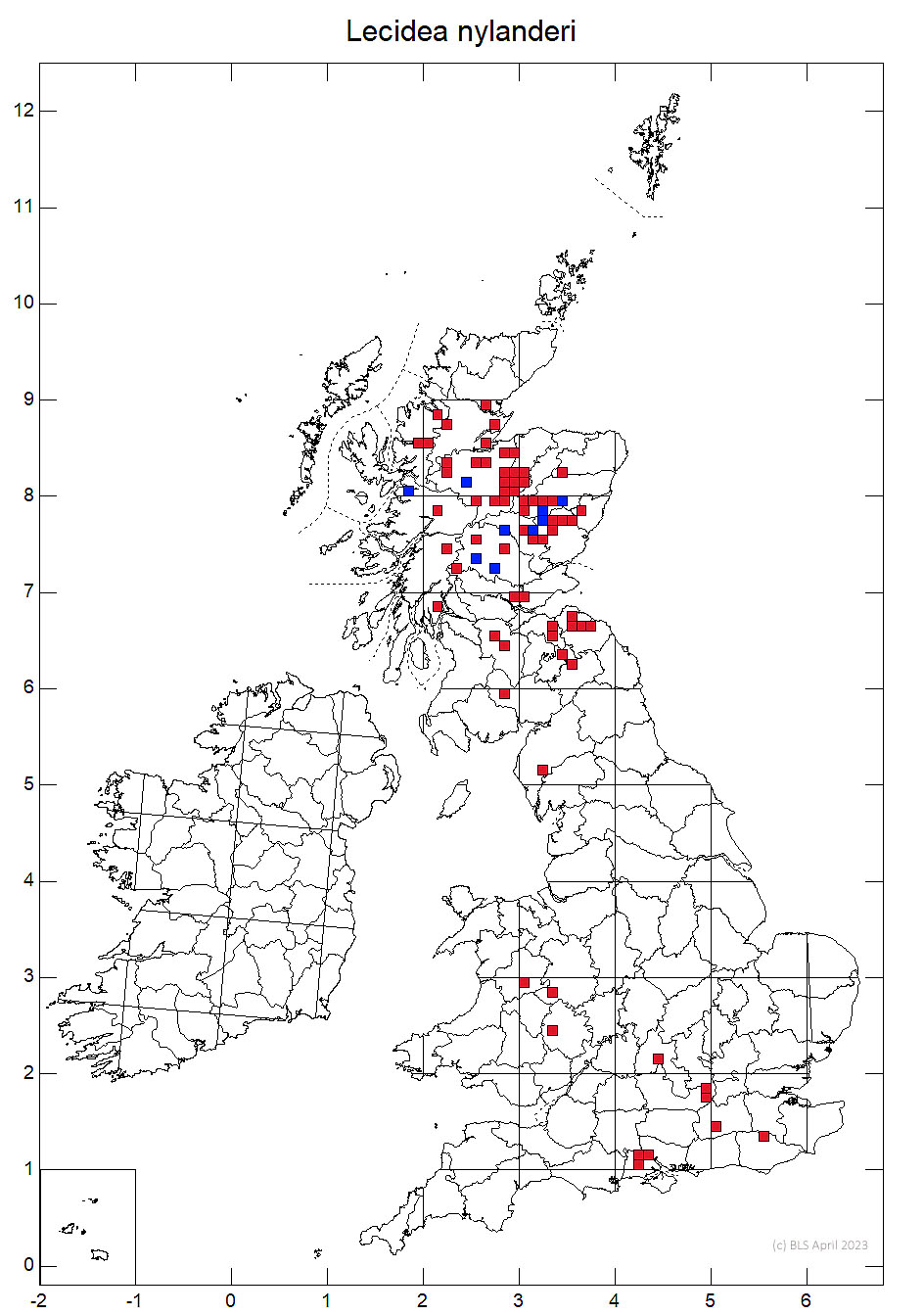Lecidea nylanderi
A lichen of acid bark and lignum, mainly found in old woodlands in the east, especially in the Scottish Highlands. It is easily to overlooked; a sorediate crust with grey-white thallus that is often mostly obscured by confluent bluish-grey soralia but the bluish-black prothallus is often distinct. Spot tests are all negative but the soralia are UV+ pale blueish white, but this can be patchy. Rather similar to the oceanic Mycoblastus caesius, but this can be separated by its easy to see and very bright white UV fluorescence.
Thallus to 20 cm across, effuse, grey-white, often tinged brownish in part, soralia varying from small and discrete to confluent and forming a bluish-grey crust; granules 20–60 (–70) µm diam.; external hyphae sometimes brown; prothallus often distinct and bluish; photobiont cells 5–12 (–14) µm diam. Apothecia (not seen in British material) 0.2–0.5 (–0.9) mm diam., pale to dark red-brown, flat to slightly convex; true exciple thin, pale brown, the outer part sometimes darker; epithecium brown, K–; hymenium 35–40 µm tall, colourless; hypothecium colourless; paraphyses unbranched, the apices abruptly swollen with dark brown caps to 4 µm diam. Asci Bacidia-type. Ascospores 6–7 µm diam., globose. Thallus C–, K–, KC–, Pd–, UV+ pale blueish white (divaricatic acid).
The UV fluorescence in Lecidea nylanderi is typically quite pale and not that easy to see, often it is only apparent deeper inside the soralia. Difficult to separate from sterile Hertelidea botryosa except by TLC (both species are UV+ white), although the latter usually has a darker grey-brown thallus [as H. botryosa contains perlatolic acid actually the fluorescence should be much brighter and whiter, but this needs testing]. Mycoblastus caesius often has a conspicuous grey-blue-black prothallus, and Lecidea nylanderi can look similar, but M. caesius contains perlatolic acid and has a much brighter UV fluorescence, and also has blue-grey hyphae in some soredia. The prothallus of L. nylanderi also helps to separate strongly sorediate morphs from Lepraria incana s. str., which also has divaricatic acid and is UV+ pale bluish white.
Lecidea nylanderi was shown to belong in the Lecanoraceae by Schmull et al. (2011), confirming observations by Edwards et al. (2009) that it belonged to an unnamed genus centred on Lecanora fuscescens. That position was agreed by Øvstedal et al. (2019), but again without formally introducing a new genus.
On bark and lignum of old trunks of Pine, Birch and Juniper, especially in old oak-birch or pine-birch woodlands, rare on Oak lignum in England and Wales in pasture woodland and parklands.

Widespread in an area centred on the eastern Scottish Highlands and S.E. Scotland, rare in the Welsh Marches and S.E. England.
Mainly found in old woodlands
Britain: Notable
Wales: not assesed
Edwards, B., Aptroot, A., Hawksworth, D.L. & James, P.W. (2009). Lecanora. In: Lichens of Great Britain and Ireland (Smith, C.W., Aptroot, A., Coppins, B.J., Fletcher, A., Gilbert, O.L., James, P.W. & Wolseley, P.A. eds): 465–502. London: British Lichen Society.
Fryday, A., Cannon, P., Coppins, B., Aptroot, A., Sanderson, A. & Simkin, J. (2024). Lecideales, including Amygdalaria, Bellemerea, Bryobilimbia, Cecidonia, Clauzadea, Farnoldia, Immersaria, Koerberiella, Lecidea, Lecidoma, Porpidia, Porpidinia and Romjularia (Lecideaeae) and Lopadium (Lopadiaceae). Revisions of British and Irish Lichens 40: 1–51.
Øvstedal, D.O., Fryday, A.M. & Lewis Smith, R.I. (2019). Lecanora muscigena (Lichenized Ascomycota, Lecanorales), a new lichen species in the Lecanora fuscescens group from South Georgia. New Zealand Journal of Botany 58: 145–152.
Text by Neil A. Sanderson based on Fryday et al (2024)


